Humboldtlocal is a cannabis gardener from Garberville, California, 40.1° north latitude, about 20 miles (32.2 km) from the Pacific Ocean, tucked into a valley behind the King Range of mountains and the Lost Coast. The winters are rainy and summers are hot. Cannabis gardens require irrigation.
This garden is located on the border of the legendary Humboldt and Mendocino counties in Northern California, where Humboldtlocal grows big plants. Very big plants—10 pounds (4.5 kg) plus.
Many states that allow legal medical cannabis cultivation limit the number of plants a patient or a patient caregiver can grow. They therefore grow big plants that produce more medicine—legally.
There are no secret tricks to growing giant plants. The only requirements are simple, consistent organic garden practices and proper genetics in the seeds or clones that are acclimated to your local climate. Of course, strong knowledge of biology, horticulture, and soil and water chemistry always helps! Once the genetics are secured, the most important factors to grow big plants are a long growing season (6 to 7 months), and plenty of light, good soil, clean water, and desire.
The big plants cost from $300 to $500 USD per plant to grow, which includes all labor, supplies, rents, and so forth. The production cost is $50 USD per pound (0.45 kg). Healthy harvests weigh in at 5 to 10+ pounds (2.3–4.5 kg) of dried flower tops and about the same volume in leaves. Post-harvest expenses such as trimming, drying, and storing are not included in these estimates.



So much of harvesting a big crop has to do with timing and the weather. In 2010, Humboldtlocal got lucky. Seeds were started at the optimal time for the climate. Seedlings were transplanted at the right times. The weather made it easy to give them optimal conditions. Once transplanted into hoop houses, the plants took off! Plants were transplanted and moved to the hoop houses on April 20, 2010. (The late spring in 2011 prevented the move to hoop houses until July 1 that next year. Of course, harvest was affected.)
March

On the night of March 3, the plants were looking good in the heated greenhouse, but a sudden storm had blown in and covered the ground with snow. The little quail around the farm sought shelter from the storm by ducking into the heated greenhouse. There they found a banquet of tender young seedlings, and picked and munched the seedlings for hours before slipping out at daylight. The next day there were feathers and bird poop everywhere. The fan leaves had been pecked away but the growing tips were untouched. With no other plants ready to go, Humboldtlocal decided to nurse them back to health and plant them in the garden.

The little clones were looking better just a few days after the viscous quail attack.

Planted on the first of March, these seedlings were 3 weeks old when this photo was taken. They were growing in 1-gallon (3.8 L) containers full of Humboldtlocal’s homemade potting mix. Each plant was meticulously labeled with variety name, planting date, and transplanting date.
Nighttime temperatures dip as low as 40ºF (4.4ºC) in this area of California, but a small heater kept the interior of the greenhouse between 55ºF and 60ºF (12.8ºC–15.6ºC).

It is hard to believe that the little seedlings that were attacked by a covey of quail could produce big healthy plants like this one just a few months later. Mother Nature works in miraculous ways.

This is the site for the garden. It is in the best possible place located on flat land. The entire parcel receives full sun all day long. Large fir trees around the perimeter protect the big garden from strong Pacific Ocean winds.
In 2010, tools, irrigation equipment, soil, fertilizer, and everything else had to be carried to the garden. All gardens need a readily available source of water, or it too must be hauled to the site. Plants can use 5 to 10 gallons (18.9– 37.9 L) of water a day. The water source for this garden is a nearby pond.
Local varieties were planted that were developed to grow well in this climate. Smart gardeners in Northern California grow seeds and clones developed locally for their own climate.
Clones or seedlings can be started indoors or outdoors in a heated greenhouse in temperate climates. Small plants can be moved from indoors to a heated greenhouse when plants are a month old.
April

The result of the quail attack was positive! By April 15 the seedlings were 12 to 18 inches (30.5–45.7 cm) tall and had started showing male and female pre-flowers. Seedlings were bushier and demonstrated sex earlier than in other years. Empirical observations say it was from the attack of the killer quail.

Here are the same seedlings 8 days later. They had grown so quickly that the plants were shading one another. They had to be moved apart and transplanted because roots had also overgrown the 1-gallon (3.8 L) containers.

This indoor garden room was full of ‘OG Kush’ and ‘Mr. Nice’ clones. They were moved into a hoop house just days after this photo was taken. The greenhouse was wired with CFL lamps to provide just enough light to prevent flowering under fewer hours of sunlight.

The ‘OG Kush’ plants were transplanted into 5-gallon (18.9 L) pots. The greenhouse protected the plants from heavy spring rains, and the supplemental light kept them in the vegetative growth stage.
May

This row of seedlings was planted directly in amended soil. Irrigation tubing was laid alongside plants. Next a string of lights would be installed overhead to keep plants in the vegetative growth stage.

By May 12, plants in the greenhouse were continuing to put on new growth. They would be transplanted into hoop houses outdoors in the next few days.
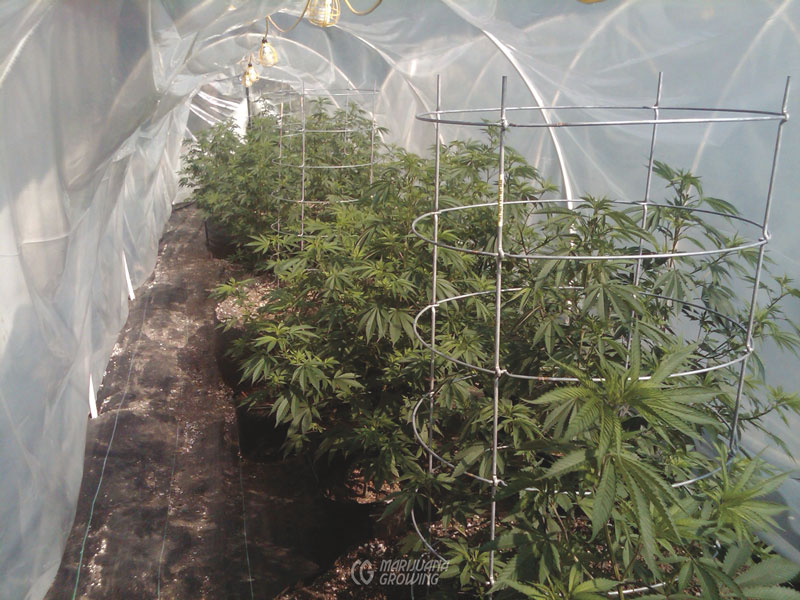
Small CFL lamps illuminated this hoop house full of ‘Mr. Nice’ in the springtime to keep plants in the vegetative growth stage.

Here the ‘Shoe Goo’ variety was also kicking into gear.

Here is the ‘Burmese Kush’ × ‘Shoe Goo’, as it was starting to get cranking.

Containers were large (200–300 gallons [757.1–1,135.6 L]) and organic soil was rich in available nutrients; it drained well, and retained moisture too. The soil was covered with permeable weed barrier cloth and 300-gallon (1,135.6 L) pots were set on top. This practice contained the root ball and conserved water.

Hoop houses have access from either end. On hot days the ends can be rolled up for ventilation. Plants can usually withstand 86ºF to 90ºF (30ºC–32.2ºC) and a little more when well established. Humboldtlocal pushed his plants to higher temperatures so they would be ready for 100ºF (42ºC) temperatures in summer.
The ends of hoop houses can be closed in late afternoon to keep the heat inside during much of the night. Small hoop houses heat up faster and must be vented frequently.
Here are a couple of soil mixes from expert medical cannabis gardeners from the Emerald Triangle in Northern California. Both soil mixes are similar. Humboldtlocal’s mix includes dolomite, oyster shells, and kelp as additional sources of calcium, magnesium, and trace elements. Nitrogen is also supplied by worm castings and chicken manure. Tom Hill’s soil mix relies on Brix Mix for trace elements and does not add magnesium and calcium in the form of dolomite. Ever seeking the perfect soil mix, both gardeners change their mix slightly every year.
| Humboldtlocal’s Soil Mix |
| Makes 50 cubic feet (1,415 L) of soil Fills 6, 300-gallon (1,135.6 L) containers 25, 1.5 cubic-foot bags (42.5 L) Sunshine Natural and Organic #4 3 cubic feet (85 L) Nutri Rich high-calcium chicken poop 1 cubic feet (28.3 L) Super Soil Earthworm Castings 4 cubic feet (113.3 L) Pahroc Perlite #4 25 pounds (11.3 kg) steamed bone meal 5 pounds (2.3 kg) kelp 5 pounds (2.3 kg) oyster shells 20 pounds (9.1 kg) dolomite lime 20 pounds (9.1 kg) gypsum Mix well, water thoroughly; let rest for minimum of 2 to 3 weeks before using. |
| Tom Hill’s Soil Mix |
| Makes 50 cubic feet (1,415 L) of soil Fills 6, 300-gallon (1,135.6 L) containers 25, 1.5 cubic foot-bags (42.5 L) good-quality organic potting soil 4 cubic feet (113.3 L) chicken manure 4 cubic feet (113.3 L) perlite 50 pounds (22.7 kg) steamed bone meal 20 pounds (9.1 kg) gypsum Mix well, water thoroughly; let rest for minimum of 2 to 3 weeks before using. Add Brix Mix Powder as per package instructions a week before moving in transplants. |
June

These 300-gallon (1,135.6 L) containers were planted in early May with no protection from wind and cool weather. Each container held 2 or 3 plants. Although the plants were smaller than plants in hoop houses, the extra number of plants took advantage of large containers full of great soil.

Drip irrigation tubes encircle the plant.
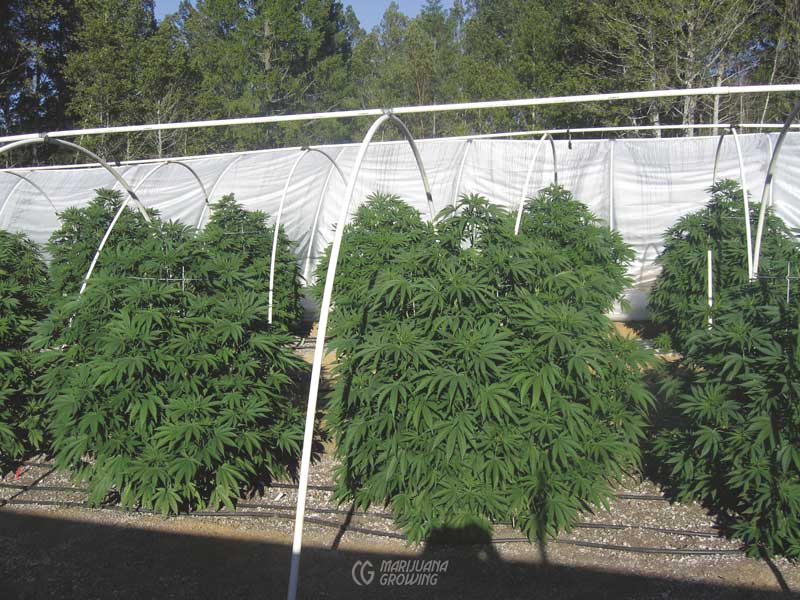
These plants were spaced on 10-to-12- foot centers—a bit close. Humboldtlocal wanted them to look like a big, continuous hedge from the air.

Hoop houses made with 20-foot (6 m) PVC pipe are 6 to 7 feet (182.9–213.4 cm) tall at the crown. They are designed so that plants outgrow hoops by several feet. The plastic is taken off as soon as nighttime weather warms, usually late June to early July. Two 4-foot-wide (121.9 cm) trellis nettings were run down the length of Humboldtlocal’s hoop house. The plants grew through the trellis netting and were supported. Hoop houses are not covered when autumn rains come because bud mold and mildew are compounded in dense foliage. Rain can always be shaken off.

Rice straw makes good mulch and was readily available in Humboldtlocal’s area. It was not full of seeds, but rodents loved it. Humboldtlocal relied on the skills and appetite of several farm cats to keep the rodent population in check. However, an occasional plant was lost to girdling of the stem.

Water is essential during the entire cannabis life cycle. Humboldtlocal irrigated each plant with 20 gallons (75.7 L) every other day.
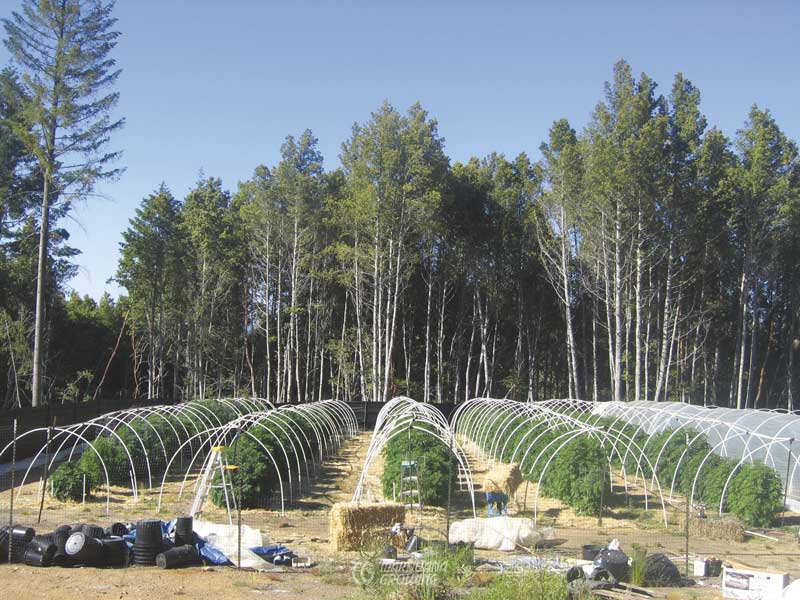
Here is the same view of the main garden a few months later. The plants stood 6 to 7 feet (182.9 213.4 cm) tall.
July


Instead of using commercial bottled fertilizers, Humboldtlocal used a “hot” soil mix and top-dressed with high-nitrogen bat guano and earthworm castings during vegetative growth. He changed to high-phosphorus bat guano during flowering. He also used a local compost tea that was rich in micronutrients, as well as earthworm castings (EWC) diluted in water as a soil drench.

However, he did use a couple of organic mite and pest sprays. During this gardening year he started using Brix Mix as a foliar spray; it is known to repel and kill insects and mites.

By mid July vegetative growth was full speed ahead. This shade leaf was big enough to cover half of the gardener’s back!
Organic gardening is the secret to huge plants and rock-hard buds. Good genetics play a major role as well.
August

For large plants, it takes a huge stem to support branches and foliage. This stem grew so fast that it got stretch marks. Stretch marks are usually the result of infrequent watering.

Water is the key to success when growing large plants. These plants needed 20 gallons (75.7 L) or more every other day (10 gallons [37.9 L] daily) to sustain life and continue to grow.

Irrigating in the morning ensures that much of the water is used during the first part of the day. Roots do not go to bed with wet feet, and oxygen is able to speed nutrient uptake.

Chance of bud mold and powdery mildew increases exponentially when sprays are applied in the evening. Extra moisture is a sure breeding place for fungus.

Hoop houses are able to follow the contour of the land.
September
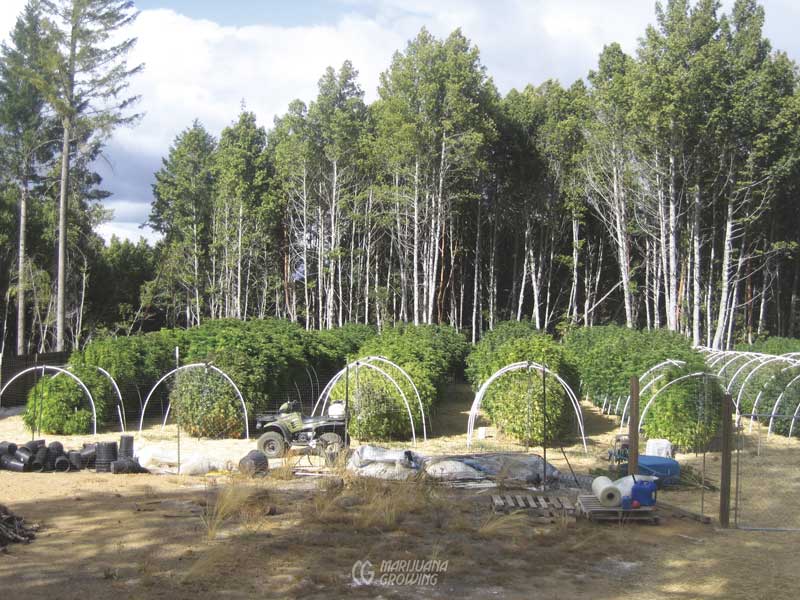
This photograph was taken on September 8, but the view itself had appeared two times in the year, in March and June. You can see that some of the plants in the foreground had been harvested once. New growth had sprouted up, and light-starved flower buds had already begun plumping up.

By September 8, plants had grown 2 to 3 feet (61–91.4 cm) past the first layer of trellis netting. Buds were starting to flap in the wind. Luckily, branches were tough, and no damage occurred.

Plants had grown to more than 12 feet (365.8 cm) tall by September 20, and a second trellis netting was added to help protect bud-laden-branches from wind damage.

These plants will ultimately obscure the plastic netting.

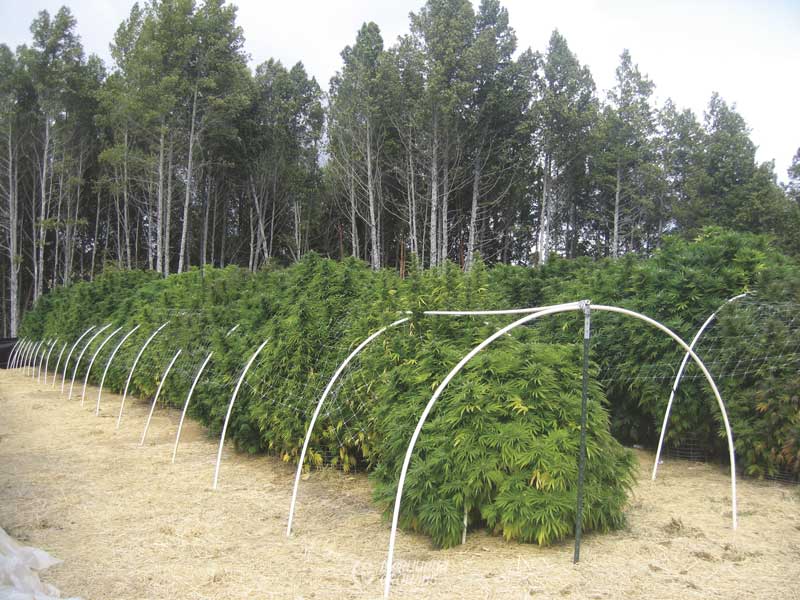
During the flowering stage, budding plants received fertilizer. Progressively more of the bloom formula was added in 2 to 3 fertigations, until the fifth or sixth week.
October
Harvesting a field of 10-pound (4.5 kg) plants required space, planning, and a lot of hard work!
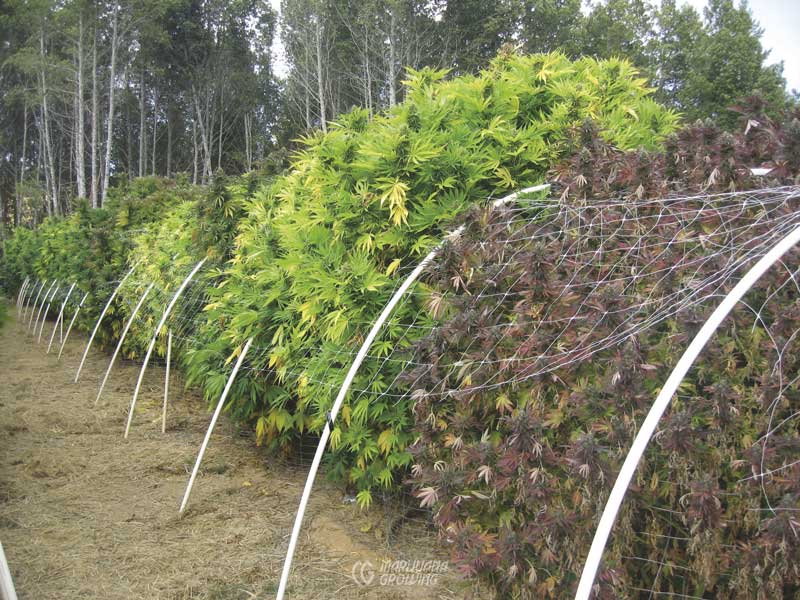
By the first of October, a 2-foot (61 cm) layer of bud-filled branches had been harvested from the purple plant in the foreground. Two weeks later, the secondary buds were fattening for harvest.

This is the photograph that was seen in more than 20 magazines and countless digital media outlets around the world. For many gardeners, Humboldtlocal and the growers in the Emerald Triangle of Northern California provide the inspiration to grow big plants beyond their wildest dreams!

This photo provides perspective on the size of some of the plants in this garden.

After being machine-trimmed, buds are hand-manicured to remove excess foliage before they are placed on net shelves to dry.
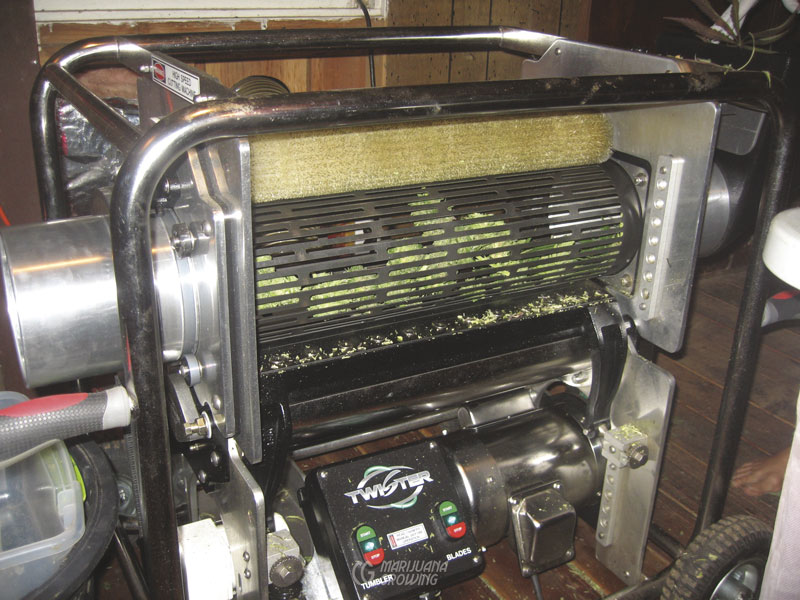
A Twister trimming machine trims most of the small leaf. Buds are prepared and dropped in the hopper. They pass through the cutting deck, where the small leaves are trimmed from compact fresh buds.

Once buds pass through the cutting deck they fall out into a receptacle. Machine-trimmed buds are taken to a table full of professional trimmers with scissors. The trimmers manicure the fresh buds to perfection.

Manicured buds are placed in expandable net drying racks. One half-pound (226.8 gm) will easily fit on a tier of these 2-foot (61 cm) drying racks suspended from eyebolts in the ceiling.

Beautiful bud!

